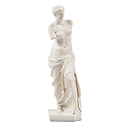
Sculpture Aphrodite, known as the Venus de Milo - From 16 to 50 cm
Hand-patinated resin reproduction. The small 16 cm version is presented on a base. Mold made from an impression of the original work on display at the Louvre. This statue occupies an important place in the history of Greek sculpture and the taste for antiquity.
It is in fact an original Greek sculpture, dated circa 100 BC, discovered by chance in 1820 on the island of Melos (known as Milo), in the south-western Cyclades, by a peasant, not far from the ruins of an ancient theater.
The style, sometimes described as retrospective, is characteristic of the late Hellenistic period, reviving classical themes while breaking new ground.
The artist certainly drew on the experience of classical Greek art. The Venus de Milo follows in the tradition of the theme created two centuries earlier by the sculptor Praxiteles. But the master of the Louvre's Aphrodite was able to free himself from the legacy of the past and demonstrate his creative originality.
While the expression on the face retains a somewhat severe coldness that could be described as classical, the body calls for other comments.
Entirely animated by a twisting movement, it inscribes itself in all dimensions of space and is truly felt as a work in the round.
The moving silhouette, the swirling attitude and the realistic modelling all speak to the genius of the statue's creator.
On March 1, 1821, it was presented to Louis XVIII, who immediately donated it to the Louvre. As soon as it was discovered, the Venus de Milo was universally celebrated. Its arrival in France, a real event at the time, was consecrated by the minting of a commemorative medal.
And this pious admiration was never to be eclipsed. It's thanks to this veneration that it has never been completed, as was the custom in the 19th century for antique statues to be presented in their entirety. The many casts presented here and there in European capitals bore witness to the infatuation aroused by the statue that the German Romantic poet Henri Heine (1797-1856) called Notre Dame de la Beauté (Our Lady of Beauty).
The sculptor Auguste Rodin (1840-1917) praised her splendid belly, as wide as the sea.
The poet Leconte de Liste (1818-1894) described her as follows:
Pure as lightning and harmony, O Venus, O beauty, white mother of the gods.
Login to see prices Sold by GrandPalaisRmnCharacteristics
- Maintenance
- Ne pas exposer à une source de chaleur directe. Nettoyage : chiffon doux et sec
- Artist
- Anonymous
- Material
- Resin
- Material of the original work
- Marbre de Paros
- Theme
- Europe
- Art movements
- Greek, Etruscan and Roman Antiquities, Gallo-roman antiquities, Antiquités gréco-romaines
- 6.3"
- Reference
- RB002126
- EAN
- 3336721121357
- Model dimensions
- 5.5cm x 5.5cm x 16cm
- Package Dimensions
- 5.5cm x 5.5cm x 16cm
- 11.8"
- Reference
- RB002007
- EAN
- 3336721120428
- Model dimensions
- 10cm x 9.5cm x 30cm
- Package Dimensions
- 9cm x 10cm x 29.7cm
- 19.7"
- Reference
- RB002008
- EAN
- 3336721120435
- Model dimensions
- 15cm x 14cm x 50cm
- Package Dimensions
- 14cm x 15cm x 49cm
- Conservation museum
- Paris - Musée du Louvre













